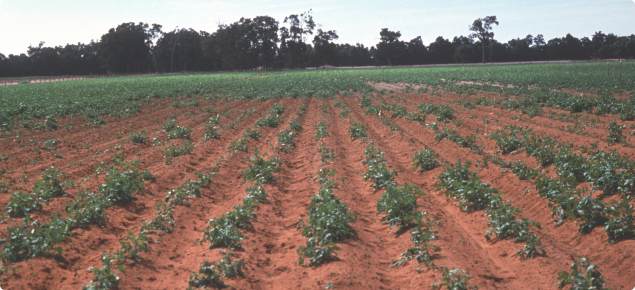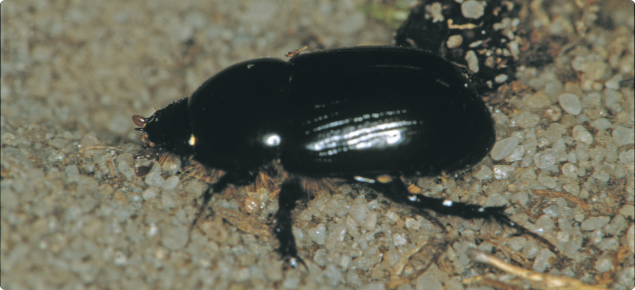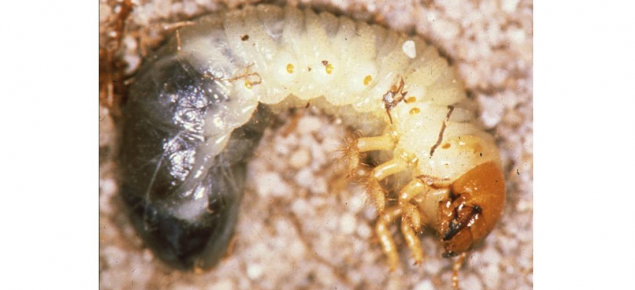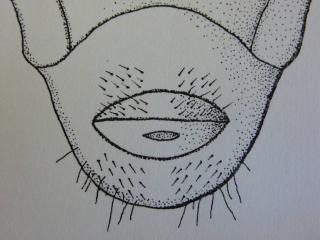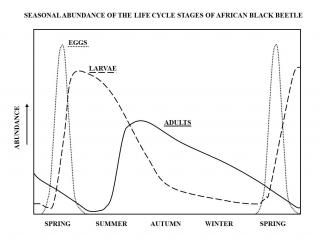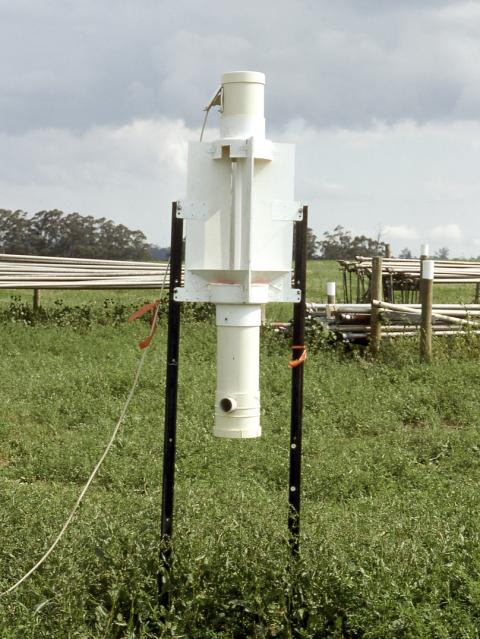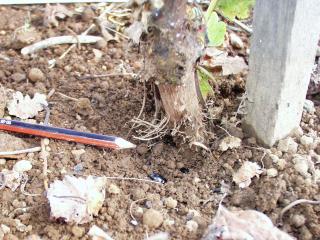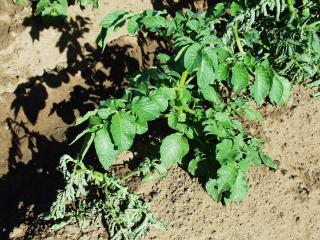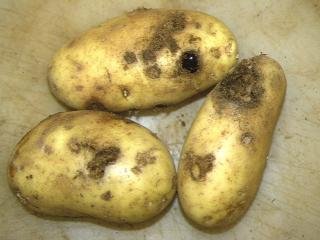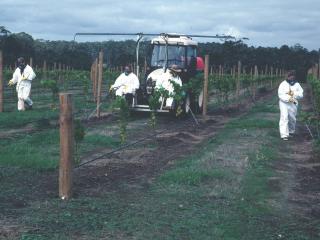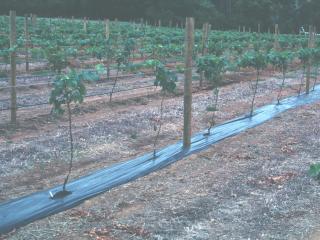Background
The adult beetle is the main pest stage. The soil-dwelling larval stage is present for only three to four months each year.
Adult beetles are economically important because they attack a wide range of plants including:
- pasture, particularly newly-sown ryegrass and perennial grasses such as couch and kikuyu
- barley, triticale and wheat, but oats is not attacked as readily
- irrigated and dryland summer forage such as millet and maize
- turf
- many vegetable crops, most importantly potatoes
- grapevines, olives and trees in truffle orchards
- ornamental plants and newly-planted trees such as blue gums.
Larvae are less economically important but can damage turf and underground crops, notably potato tubers.
Description and life cycle
Adults (beetles)
Newly emerged African black beetle adults are brown and fairly soft, but within hours they harden and darken to a glossy black. They are 12 to 14mm long with females being slightly larger than males. The end segments on the front legs of females are the same diameter as other legs, but are thicker on males.
Adults are strong fliers, even though they are regarded as 'pseudo soil insects' because they feed near or just under the soil surface on plant stems and roots.
Eggs
Eggs are cream to white, oval and about 1.8mm long. Eggs are laid singly into the soil just under the vegetation mat, and can be seen clearly with the naked eye. They may be confused with eggs of other beetles, snails and slugs. Females lay about 30 eggs each in their lifetime.
Larvae
The larva is a typical C-shaped cockchafer with a brown head capsule, black jaws and three pairs of legs on the thorax.
There are three larval stages or instars. The larva moults between each instar, increasing steadily in size with each moult. The head capsule is an average of 1.4mm for first, 2.5mm for second and 4.0mm wide for third instars. Mature larvae are around 8mm diameter and 25mm long.
Larvae of the very abundant lesser pasture cockchafer (Australaphodius frenchi), is similar in appearance. However the larvae are smaller, growing to about 1.5mm in diameter and 5mm long.
African black beetle larvae are creamy-white, except for the brown head-capsule and the hind segments, which appear dark where the contents of the gut show through the body wall. From the second instar stage these larvae are easily identifiable as they are the largest and most common of the cockchafer group in pastures in the coastal areas.
The more mature large larvae of other species of cockchafer and African black beetle can be distinguished by naked eye based on the structure of the anal opening. For African black beetle, the opening and associated spines are horizontal. Other species of cockchafer larvae have a vertical anal opening.
Most larvae feed just below the surface of pasture within the main root mat. Wet conditions during the egg and first instar larval stages are fatal, but as the larvae grow their ability to cope with high moisture levels increases. In very dry soil, larvae will burrow to avoid such dry conditions.
When they have finished feeding, the larvae (about 25mm long) clear their guts, becoming more cream in colour. They steadily shorten and become more rounded as they change into the pupal stage.
Pupae
The pupa or resting stage is pale yellow at first, but changes to a reddish brown as it approaches the adult stage. They are about 8mm wide and 1.5cm long.
Seasonal patterns
Life cycle stages
African black beetle has one generation per year. Adults are present during winter. Any larvae seen during winter are late developers from the previous summer and do not survive. Adult beetles mate in spring and lay eggs under the soil surface.
Adult numbers decline in spring as the old generation dies off, and larvae develop during late spring to summer. Young larvae do not tolerate high soil moisture, and mortality can be high in wet spring weather. As older larvae have a high mortality rate due to the dry WA summer conditions, many do not become adults. This is unlike the eastern Australia where summer rainfall is greater and the survival rate of larvae is higher.
As with all insects, the rate of growth depends on temperature. Because of higher temperatures in northern parts of the beetle’s distribution such as around Gingin, development stages such as mating, egg-laying and abundance of larvae peak about six weeks earlier than in southern areas around Albany.
Flying and walking
The triggers for flight are not known. Weather conditions associated with summer thunderstorms seem to promote swarming flights of beetles. Most flight activity occurs in late summer-autumn, which coincides with the emergence of the new generation of adults.
Some flight activity also occurs in spring, when adults mate and lay eggs. In spring the level of crawling of adults is much greater than flight. Beetles crawl on the soil or pasture surface at night.
Large scale flights are sporadic and may be localised within a district, making them difficult to predict. Large flight events may be monitored with lights (shed/street) or an insect light trap.
Pest status
African black beetle is primarily a grass-favouring, pasture-dwelling insect.
As such, most of its pest status in horticulture results from planting crops in infested pasture.
Because of the beetle’s strong flight activity, crops may become infested when the beetles disperse. Less commonly, crops may be infested along edges after beetles walk into a crop from adjacent infested pasture.
Where irrigation is used in horticultural crops, the higher survival rate for larvae in summer may lead to greater damage from both larvae and subsequently adults.
Adult beetles feed on plant stems near the soil surface. This occurs in vineyards, fruit and truffle orchards, olive groves and newly emerging vegetables such as potatoes and vegetable brassicas.
In vineyards, the foliage of red grape varieties attacked by beetles turns red prematurely. In white grape varieties, foliage of damaged vines turns yellow. Young stems in potato crops wilt and die.
As well as affecting plant establishment, adult beetles can feed directly on the harvestable portions of crops. This applies to potato tubers and occasionally truffles.
Larvae are true soil insects, feeding on organic matter and below-ground parts of plants.
Larvae are less damaging than the adults, and rarely damage crops or pasture. However, they can damage potato tubers if crops of appropriate maturity coincide with the presence of mature larvae - December to January.
Larvae feeding on the roots of turf result in dead patches in lawns.
Monitoring
In susceptible regions of WA - primarily the higher rainfall areas adjacent to the south-west and southern coasts - consider monitoring for African black beetle adults prior to planting.
Adult flight activity can be monitored during summer or autumn by using light traps, or observing activity around lights near buildings and street lights. High levels of flight activity indicate the possibility of crop invasion.
Adult beetles occur no deeper than 15cm in soil, and are usually just below the soil surface.
Spade sampling across a paddock can be used to gauge their abundance. This can be estimated by considering that 44 x 15cm square spade samples = 1 square metre. More than three adult beetles per square metre is considered a threat to susceptible crops.
Because beetles are clumsy walkers, they accumulate in pitfall traps or sharp-sided plough lines. A simple pitfall trap can be made using an aluminium can with the top removed, or a glass jar buried in soil to ground level.
Sentinel drenching with an insecticide toxic to adults can also be used to assess presence - Refer to Viticulture spray guide for Western Australia or consult the Australian Pesticides and Veterinary Medicines Authority portal.
Sprays can be applied to marked areas before planting, or the base of tagged grapevines across a block after planting. The resulting dead beetles should be counted within two days of spraying. Remedial action should be considered if there are more than three to six beetles per square metre in a paddock, or 5% or more of grapevines with beetles. Sentinel drenching may be repeated at selected times of the year or after a suspected fly-in.
Control
African black beetle is difficult to control as the soil acts as a protective blanket, and makes it difficult to judge pest abundance.
If beetles exceed the thresholds suggested above, consider the following control techniques.
Chemical
For current information on registered insecticides, consult the Viticulture spray guide for Western Australia or the Australian Pesticides and Veterinary Medicines Authority portal.
Grapevines
Resident populations of African black beetle can be reduced by applying insecticide to the soil surface in late winter, when the crawling activity of the insect increases. This may have the added benefit of controlling the insect before egg laying commences in spring, helping to reduce numbers of beetles in the area for a longer period. However, the possibility of fly-ins also needs to be considered.
When transplanting grapevines, a slow-release insecticide-incorporated polymer granule can be applied around the base of the young vines. The granules need to be covered by soil to protect them from environmental degradation.
If applied correctly and vines are managed well, granules should be active for two years. By this time the vines are large enough to no longer be susceptible to stem girdling by the beetles.
Should control of an infestation of beetles be required after transplanting vines, this can be achieved by drenching around the base of vines with an insecticide solution. The same technique can be used to monitor for the need to retreat as described above.
For detail on insecticide use in WA vineyards, consult the sources listed above.
Some of these methods may also be relevant for similar pests in other crops, provided that the insecticide is registered.
Potatoes
To control African black beetle prior to planting potatoes, incorporate insecticide to a depth of 15cm. Use a rotary hoe to ensure thorough mixing, as this maximises direct contact of the insecticide with the beetles. Relying on beetles to crawl through treated soil is less effective. Use the higher registered rates for heavy infestations as it is particularly effective in reducing stem damage, which can kill plants.
Also consider applying insecticide prior to a light rain event, as the insecticide will be less likely to be lost quickly through volatilisation and cotrol adult beetles walking on the soil surface at night. This is most relevant to controlling fly-in infestations late in a crop cycle.
The insectcide applied may not persist in soil more than one week after application at a dose sufficient to kill newly arriving beetles. Therefore pre-plant applications are not effective against beetle infestations later in the life of a crop. In high-risk situations, monior after an application and from those observations, decide whether a follow-up application is required.
Systemic insecticide seed dressings applied to protect newly planted crops have been effective in field trials against adult beetles.
Cultural
Having established the risk of damage by African black beetle, the area to be planted should be kept as bare fallow for as long as is feasible. However, susceptibility to wind and water erosion also need to be considered.
Because kikuyu is a favoured food plant that can sustain high beetle populations, consider removing it as early as possible prior to planting. Plants considered less favourable to ABB include oats, and some broadleaved plants such as lupins.
Biological
Nematodes
Larvae are susceptible to the entomopathogenic nematode Heterorhabditis bacteriophora, which occurs naturally in eastern Australia. Nematodes live in the soil and spend their lives attacking the larvae and/or pupae of African black beetle and other soil-dwelling insects. They develop on or within the insect. While nematodes are a relatively expensive option, they are suitable for high value crops such as amenity turf. For maximum effectiveness, soil temperature should be above 15°C with high soil moisture levels and the nematodes should be applied when larvar are at least half way through their development cycle. Nematodes track their host using a gradient of carbon dioxide and the larger the larva the more easily the nemtode will locate it. Also, largar larvae have large entry points such as spiracles - the breathing pores of insects.
Birds
Birds such as guinea fowl, chickens and ducks are used increasingly to control of a range of pests including adult beetles, wingless grasshoppers, garden weevil and snails.
Beetles exposed in the process of land preparation or by a winged ripper to expose soil and beetles, would assist in this form of pest management.
Physical barriers
Growguards are used in some crops to protect new plantings from herbicides and rabbits. If the growguards are buried to about 5cm, they can also prevent attack by African black beetle adults.
Another form of physical control has been developed by and for the blue gum industry. This consists of a plastic mesh sleeve placed over the root ball and along most of the stem of treelings.
These sleeves make it impossible for adult beetles to feed on stems of plants at ground level. This technique may be suitable for other crops where planting material is small enough to be placed in the sleeves, such as bare-rooted vine transplants and olive treelings.
Because beetle adults are clumsy walkers, planting into black plastic mulch on slightly raised, angled beds may help reduce the numbers of adult beetles that are able to walk to the base of plants. The plastic also assists with weed control.
Mounding
If damage to the stem of grapevines near ground level has occurred, mounding soil around the base of affected plants may enable those plants less extensivly damaged to recover. Insecticide treatment may still be required to control the beetles. Mounding may also be applicable for rejuvenating damaged blue gums, olive trees and other plants.


